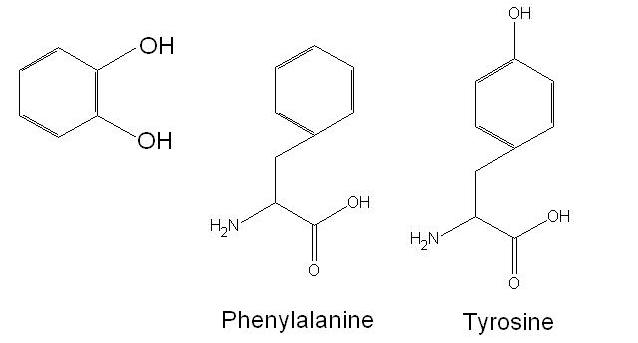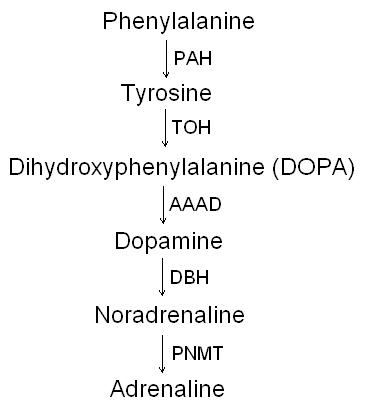Dopamine, noradrenaline and adrenaline catecholamine neurotransmitters, so named because their structure is based on catechol (figure 1). The catecholamines play an important role in the nervous system, where they are involved in activation of the sympathetic branch of the central nervous system (CNS). Dopamine is involved in the reward pathways of the brain, and adrenaline and noradrenaline are associated with alertness and motivation. Catecholamines are synthesised from L-tyrosine in a series of metabolic steps. L-tyrosine can be derived from the diet, from protein degradation or by synthesis from phenylalanine. L-Tyrosine is converted to L-DOPA by the enzyme tyrosine hydroxylase, and subsequently to dopamine by the enzyme aromatic amino acid decarboxylase. In some neurones this is the final product, but other neurones contain the enzyme dopamine-β-hydroxylase and phenylethanolamine-N-methyl transferase, which converts the dopamine to noradrenaline and adrenaline respectively (figure 2).
Figure 1. The molecular structure of a catechol, (left) with phenylalanine (centre) and tyrosine (right).
Figure 2. The synthesis of the catecholamines in neurones. Abbreviations; PAH = phenylalanine hydroxylase, TOH = tyrosine hydroxylase, DBH = dopa-β-hydroxylase, AAAD = aromatic amino acid decarboxylase, PNMT = phenylethanolamine-N-methyl transferase.
Catecholamine biosynthesis in humans is initiated by the uptake of L-tyrosine from the circulation to neurones in the CNS. Uptake across the blood brain barrier is directly related to the plasma concentrations of L-tyrosine and inversely associated with concentrations of other large neutral amino acids (e.g. tryptophan and phenylalanine). This competition results because they share a common transport system across the blood brain barrier called the L-type amino acid carrier. Evidence suggests that catecholamine synthesis can be influenced by circulating levels of precursor amino acids (i.e. L‑tyrosine). For example, research published in the American Journal of Clinical Nutrition in 19811 demonstrated that feeding L-tyrosine (100 mg / kg) as a dietary supplement to normal healthy volunteers increased plasma levels of L-tyrosine and accelerated catecholamine synthesis by 25 %, as measured by urinary excretion of total catecholamines.
The ability to increase catecholamine synthesis has potential physiological benefits in terms of mental performance and mood. For example, depression and apathy are associated with low levels of catecholamine neurotransmitters, in some current theories. Increasing the neuronal content of dopamine, noradrenaline and adrenaline may therefore provide a benefit where alertness, motivation and mental performance are required. L‑tyrosine is known to increase levels of these transmitters in neurones, but controversy still surrounds the fate of those transmitters. This is because without the neurones firing, the excess neurotransmitter appears not to be released. Because sporting and cognitive tasks do increase neuronal firing, increased neuronal content of the catecholamines produced by dietary tyrosine should be of benefit to performance. However, dietary L-tyrosine should not provide a feeling of general arousal experienced with other CNS stimulants.
RdB


